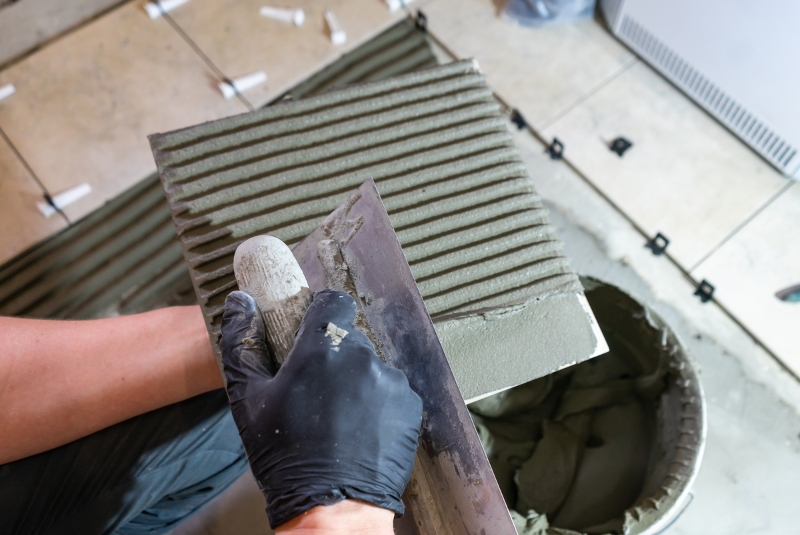As someone who has tackled various tiling projects, I understand the importance of selecting the right adhesive.
The adhesive you choose needs to be not only cost-effective but also robust and easy to apply.
Moreover, when it comes to vertical applications, concerns like sag during the curing process become significant.
Moisture is another crucial factor, as tiles are installed in environments ranging from extremely wet areas to dry spaces.
Areas with high moisture levels include shower pans, hot tubs, and swimming pools, while drier locations comprise interior residential spaces like bathrooms, kitchens, wall wainscots, and backsplashes.
When working with ceramic or porcelain tiles, liquid adhesives are essential to meet these diverse requirements and ensure a strong bond with the substrate.
Among the adhesive options, two commonly used for ceramic, porcelain, and glass tiles are mastic and thinset mortar.
However, navigating the choice between them can be perplexing due to their overlapping applications.
So, let’s delve into the details to help you decide which one suits your project best and where to use them.
Thinset Mortar: A Reliable Choice
Thinset mortar is an inorganic adhesive crafted from materials sourced from the earth.
It’s cost-effective and available in both wet, pre-mixed and dry, powdery forms. Notably, thinset comes in unmodified and modified versions.
The unmodified variety comprises Portland cement, sand, and water retention agents. In contrast, modified thinset incorporates liquid latex polymers to enhance strength and extend working time.
One of the unique features of thinset is its relatively slow curing time.
While this can be advantageous, offering ample opportunity to adjust misaligned tiles, it can also pose a challenge in vertical applications like bathroom walls and kitchen tile backsplashes.
The extended curing time can lead to tile sag. In such cases, the solution lies in liberally using plastic tile spacers.
Thinset is well-suited for various applications, including shower pans, shower walls, bathroom floors, bathroom walls, kitchen floors, kitchen countertops, and all types of floors.
Tile Mastic: The Fast Grab Adhesive
Tile mastic is a term that traditionally referred to fast-grab glues for tiles, derived from an organic plant-based resin. It was known for its sticky, gummy consistency, with the term ‘mastic’ sharing its roots with ‘masticate.’
However, finding adhesives labeled explicitly as ‘mastic’ is increasingly rare at local home centers today.
Still, adhesives that fall under the fast-grab, no-sag category are what you should be looking for, especially when working with porcelain, quarry, stone, ceramic, and mosaic tiles.
Tile mastic finds its place in many applications, including kitchen walls, kitchen backsplashes, bathroom backsplashes, and bathroom walls (if they aren’t near showers or tubs) and on walls where moisture isn’t prevalent.
Thinset vs. Mastic: A Quick Comparison
Moisture Factor: Thinset can be used in very wet areas, even those completely submerged in water.
Mastic is suitable for dry or damp areas only and should not be used in submerged locations like swimming pools.
Best Areas: Thinset is versatile and suitable for various areas, including showers, bathtubs, backsplashes, and more.
Mastic is often used for walls, wainscots, and dry backsplashes.
Pros (Mastic):
- Minimizes tile sag on vertical surfaces during curing.
- Unused mastic can be saved.
- Makes tile removal relatively easy during demolition.
Cons (Mastic):
- Quick-grab feature makes it challenging to correct misaligned tiles.
- Unsuitable for high-moisture areas.
- Strong, lingering odor.
Pros (Thinset):
- Stronger material, making it ideal for high-traffic horizontal applications like flooring.
- Dry-mix thinset is cost-effective and user-friendly.
Cons (Thinset):
- Excess thinset cannot be saved.
- Extended drying time may cause vertically installed tiles to droop during curing.
- Demolition with thinset requires significant effort.
It’s worth noting that when using thinset on surfaces other than concrete, a layer of cement board or an equivalent substrate is typically added for better bonding.
This additional step can be considered a downside due to the added complexity.

